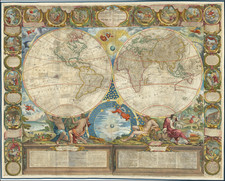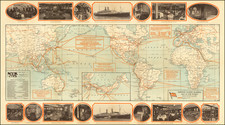This is a reduced-sized facsimile of Lorenz Fries' 1530 Carta marina, probably related to the reproduction that was published in Munich in 1926.
Fries began work on a re-issue of Martin Waldseemuller's famous 1516 wall map (likewise called Carta marina) after completing work on the 1522 edition of Ptolemy.
Fries' map was apparently completed in 1525, but no complete example of that edition exists. See, Leo Bagrow [Fragments of the "Carta Marina by Laurentius Fries, 1524, IM XIV ('S-Gravenhage: Mouton & Co., 1959), p.111-2 (ill)] about the fragments in the University of Leiden Library.
The only known example of the 1530 map is held in the Bayerische Staatsbibliothek, Munich.
The Edward Luther Stevenson Collection
Edward Luther Stevenson was among the most important scholars of early cartography active at the end of the 19th century and the first half of the 20th. He was responsible for numerous cartobibliographic books, including the first translation of Ptolemy to English, as well as a series of impressive facsimile maps produced while he was at the Hispanic Society of New York. Dr. Stevenson viewed facsimiles as integral to the study of early cartography, and he committed himself to building an unparalleled collection of photographs of early maps and globes. Much of his collection was donated to Yale University after his death (click on the title link above for about that), but the present item comes from a large collection of photos, manuscripts, and related material that were part of Stevenson's library, but were not donated to Yale. It is truly an impressive collection and many of the items, though reproductions, have serious antiquarian merit. As Alexander O. Vietor said about Stevenson collection that went to Yale "this is the stuff of which great libraries are made."
Lorenz (Laurent) Fries (ca. 1485-1532) was born in Mulhouse, Alsace. He studied medicine, apparently spending time at the universities of Pavia, Piacenza, Montpellier and Vienna. After completing his education, Fries worked as a physician in several places before settling in Strasbourg in about 1519. While in Strasbourg, Fries met the Strasbourg printer and publisher Johann Grüninger, an associate of the St. Dié group of scholars formed by, among others, Walter Lud, Matthias Ringmann and Martin Waldseemüller.
From 1520 to 1525, Fries worked with Grüninger as a cartographic editor, exploiting the corpus of material that Waldseemüller had created. Fries' first venture into mapmaking was in 1520, when he executed a reduction of Martin Waldseemüller's wall map of the world, first published in 1507. While it would appear that Fries was the editor of the map, credit is actually given in the title to Peter Apian. The map, Tipus Orbis Universalis Iuxta Ptolomei Cosmographi Traditionem Et Americ Vespucii Aliorque Lustrationes A Petro Apiano Leysnico Elucubrat. An.o Dni MDXX, was issued in Caius Julius Solinus' Enarrationes, edited by Camers, and published in Vienna in 1520.
Fries’ next project was a new edition of the Geographia of Claudius Ptolemy, which was published by Johann Grüninger in 1522. Fries evidently edited the maps, in most cases simply producing a reduction of the equivalent map from Waldseemüller's 1513 edition of the Geographie Opus Novissima, printed by Johann Schott. Fries also prepared three new maps for the Geographia, of Southeast Asia and the East Indies, China, and the world, but the geography of these derives from Waldseemüller's world map of 1507.
The 1522 edition of Fries' work is very rare, suggesting that the work was not commercially successful. In 1525, an improved edition was issued, with a re-edit of the text by Willibald Pirkheimer, from the notes of Regiomontanus (Johannes Müller von Königsberg).
After Grüninger's death in ca. 1531, the business was continued by his son Christoph, who seems to have sold the materials for the Ptolemy to two Lyon publishers, the brothers Melchior and Gaspar Trechsel, who published a joint edition in 1535, before Gaspar Trechsel published an edition in his own right in 1541.











![[Early Photographic Facsimile of the 1502 Cantino Planisphere]](https://storage.googleapis.com/raremaps/img/small/67278.jpg)

![Hemisphere Occidental ou du Nouveau Monde . . . [and] Hemisphere Oriental ou de L'Ancien Monde . . . MDCCLXI](https://storage.googleapis.com/raremaps/img/small/64273.jpg)
![Tabula Geographica Hemisphaerii Borealis ad emenatiora quae adhuc prodieruntexampla jusqu Acad. Reg. Scient. et Eleg. Litt. Boruss. descripta [with:] Tabula Geographica Hemisphaerii Australis...](https://storage.googleapis.com/raremaps/img/small/81806.jpg)